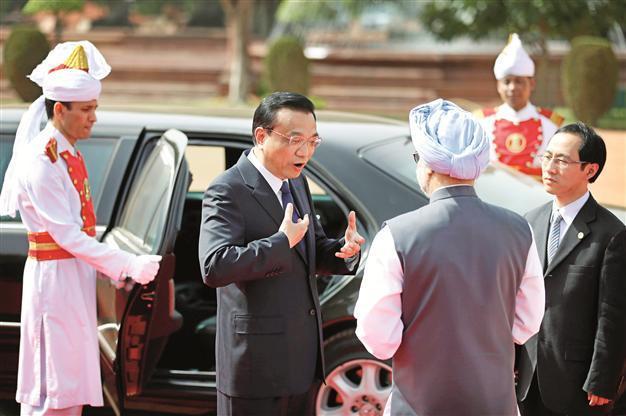Chinese premier in India visit to mend strained ties
NEW DELHI

Chinese PM Li Keqiang (L) talks to Indian Prime Minister Manmohan Singh upon Li’s arrival for a ceremonial reception at the Presidential Palace in New Delhi. AP photo
Chinese Premier Li Keqiang pledged yesterday to build trust with India and declared that ties between the Asian giants were key to world peace as he visited New Delhi just weeks after a border spat.Speaking alongside his counterpart, Manmohan Singh, Li said China wanted to increase cooperation with India, saying his choice of destination for his first foreign visit showed the importance that Beijing attached to ties with New Delhi.
“The purpose of my current visit to India is three-fold, to increase mutual trust, to intensify cooperation and to face the future,” Li said. The premier’s visit comes after a flare-up last month in a long-running border dispute between the two countries in a remote Himalayan region.
New Delhi accused Chinese troops of intruding nearly 20 kilometers into Indian-claimed territory, triggering a three-week standoff that was resolved when troops from both sides pulled back.
The Line of Actual Control between the nuclear-armed neighbors has never been formally demarcated, although they have signed accords to maintain peace in the region that was the site of a brief Indo-Chinese war in 1962.
Largest trade partner
Singh said he had agreed with his Chinese counterpart to make a new push to settle a long-running border row, pledging his commitment to “peace and tranquility.”
“We agreed that our special representatives will meet soon to continue discussions seeking an early agreement on a framework for a fair, reasonable and mutually acceptable boundary settlement,” Singh said after talks with Li. “Peace and tranquility on our border has to be preserved,” Singh added at a press conference in New Delhi. Bilateral trade between the two countries touched $73 billion in 2011, making China India’s largest trading partner but slipped to $66 billion last year.
Singh told Li it was important to balance out trade as the two countries aim for $100 billion in bilateral trade by 2015. India is pressing for greater access for its pharmaceuticals and IT services.
There are other tensions which run high between the two nations too. China already sees itself as Asia’s great power, while India hopes its increasing economic and military might, though still far below its neighbor’s, will eventually put it in the same league.
While China has worked to shore up relationships with Nepal and Sri Lanka in India’s traditional South Asian sphere of influence, India has been venturing into partnerships with Southeast Asian nations. Other irritants remain in the bilateral relationship. China is a longtime ally and weapons supplier to Pakistan, India’s bitter rival.
Also, the presence in India of the Dalai Lama, Tibet’s spiritual leader, and the self-declared Tibetan government-in-exile are a source of tension. China accuses the Dalai Lama of wanting to split Tibet off from the rest of China, but he says he seeks more autonomy for Tibetans, not independence.
















